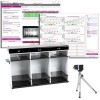Authors
P.-H. Cheng, C.-H. Li, L.-S. Her, Y.-F. Chang, A. Chan et al.
Lab
National Cheng Kung University, College of Medicine, Department of Physiology, Tainan, Taiwan.
Journal
Brain Structure and Fonction
Abstract
Huntington's disease (HD) is a genetically neurodegenerative disease, affecting the central nervous system and leading to mental and motor dysfunctions. To date, there is no cure for HD; as a result, HD patients gradually suffer devastating symptoms, such as chorea, weight loss, depression and mood swings, until death. According to previous studies, the exon 1 region of the huntingtin (HTT) gene with expanded CAG trinucleotide repeats plays a critical role in causing HD. In vitro studies using exon 1 of HTT fused with green fluorescent protein (GFP) gene have facilitated discovering several mechanisms of HD. However, whether this chimera construct exerts similar functions in vivo is still not clear. Here, we report the generation of transgenic mice carrying GFP fused with mutant HTT exon 1 containing 84 CAG trinucleotide repeats, and the evaluation of phenotypes via molecular, neuropathological and behavioral analyses. Results show that these transgenic mice not only displayed neuropathological characteristics, observed either by green fluorescent signals or by immunohistochemical staining, but also progressively developed pathological and behavioral symptoms of HD. Most interestingly, these transgenic mice showed significantly differential expression levels of nuclear aggregates between cortex and striatum regions, highly mimicking selective expression of mutant HTT in HD patients. To the best of our knowledge, this is the first report showing different nuclear diffusion profiling in mouse models with transgenic mice carrying the exon 1 region of mutant HTT. Our model will be beneficial for tracing the expression of mutant HTT and accelerating the understanding of selective pathological progression in HD.
BIOSEB Instruments Used:
Tail Suspension Test - Wireless (BIO-TST5)

 Pain - Thermal Allodynia / Hyperalgesia
Pain - Thermal Allodynia / Hyperalgesia Pain - Spontaneous Pain - Postural Deficit
Pain - Spontaneous Pain - Postural Deficit Pain - Mechanical Allodynia / Hyperalgesia
Pain - Mechanical Allodynia / Hyperalgesia Learning/Memory - Attention - Addiction
Learning/Memory - Attention - Addiction Physiology & Respiratory Research
Physiology & Respiratory Research
 Pain
Pain Metabolism
Metabolism Motor control
Motor control Neurodegeneration
Neurodegeneration Cross-disciplinary subjects
Cross-disciplinary subjects Muscular system
Muscular system General activity
General activity Mood Disorders
Mood Disorders Other disorders
Other disorders Joints
Joints Central Nervous System (CNS)
Central Nervous System (CNS) Sensory system
Sensory system
